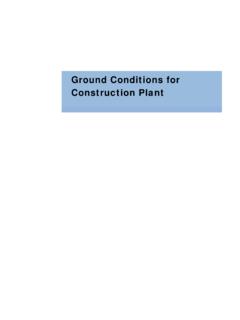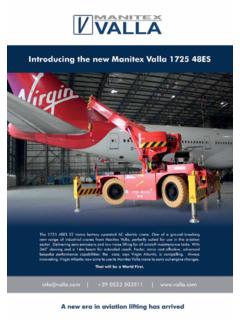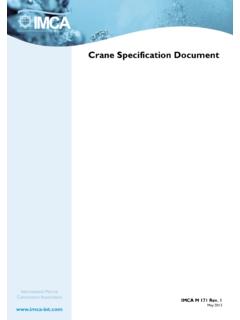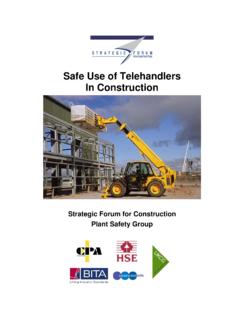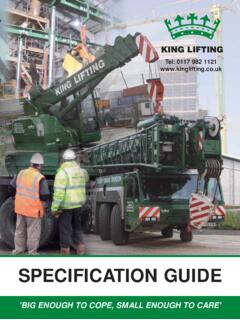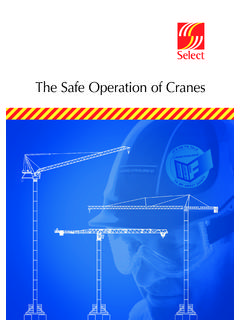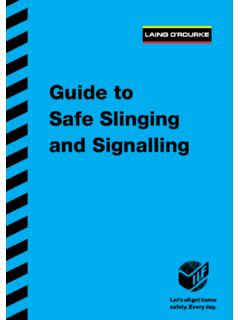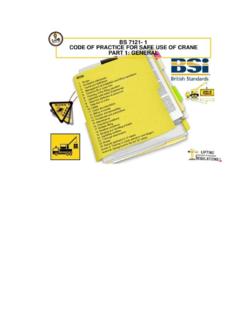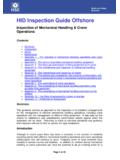Transcription of Maintenance, Inspection and Thorough …
1 maintenance , Inspection and Thorough examination of mobile Cranes Best Practice Guide maintenance , Inspection and Thorough examination of mobile Cranes CPA Best Practice Guide Working in Partnership Reference No. CIG 1001 First Published: June 2010 Published by: crane Interest Group (CIG) Construction Plant-hire Association 27/28 Newbury St London EC1A 7HU Telephone: 020 7796 3366 Email: CPA Copyright June 2010 Contents Page Foreword 1 1. Introduction and Summary 2 2. Definitions 5 3. Legal Requirements 7 4. Approaches to maintenance 11 5. maintenance Intervals 15 6. maintenance Personnel - Attributes, Training and Assessment 16 7. Information for maintenance 19 8. Inspection During maintenance 21 9. maintenance Records 23 10. Management Review of maintenance Records 24 11. Site Issues for maintenance 25 12. Spare Parts 28 13. maintenance Facilities and Equipment 30 14.
2 Approaches to Thorough examination 37 15. Management of Thorough examination 41 16. Competent Persons Attributes, Training and Assessment 44 17. Developing the Defined Scope of Thorough examination 47 18. Reports of Thorough examination 51 19. Management Review of Thorough examination Records 53 20. Practical Issues for Thorough examination (Best Practice in Depots) 54 21. Practical Issues for Thorough examination on Site 57 22. Lifting Accessories 60 Annex 1 Work at Height 61 Annex 2 Example of a typical Safe System of Work for Thorough examination Activities 68 Annex 3 Example of a Defined Scope of Thorough examination for a mobile crane 74 Annex 4 Sample Document Covering maintenance and Thorough examination Issues for mobile crane Users 80 Annex 5 Typical In-service maintenance Schedule 84 Annex 6 Daily Pre-use Checks and Weekly Inspections 85 Annex 7 Example of a Lifting Accessory Register 86 Annex 8 Example of the Use of Key Performance Indicators for maintenance 87 Annex 9 Example of the Use of Key Performance Indicators for Thorough examination 89 Annex 10 Supplementary Reports and Tests Supporting Thorough examination 90 Annex 11 Qualifications and Assessment of maintenance Personnel 94 Annex 12 Grey Imports 95 Bibliography 97 Index 100 Working Group Membership 102 NOTE.
3 Whilst every care has been taken to ensure the accuracy of the material contained within this booklet, no liability is accepted by the Construction Plant-hire Association in respect of the information given. No material from this booklet may be reproduced in any shape or form without the permission of the Construction Plant-hire Association. 1 Foreword Every year, the construction industry is responsible for causing deaths and serious injury. In recent times the industry has done much to improve its performance which I welcome, but there is always room for more improvement. Our construction industry relies on the use of mobile cranes to move materials on sometimes small, confined sites. mobile cranes are an essential part of the construction process and can help resolve some of the safety problems on site arising from space constraints. mobile cranes are often used in close proximity to people. The transportation, set up and use of mobile cranes provide the potential for death and serious injury to occur and indeed tragically, both site workers and members of the public off site have been killed in mobile crane accidents.
4 In addition to the terrible cost in human suffering, accidents have a financial cost. There is a very strong business case for improving safety performance. The law relating on cranes is clear. There are requirements to ensure that cranes are inspected, examined and maintained to ensure they do not present a risk. However, investigations into recent accidents have shown that enhanced standards of maintenance and Thorough examination could have reduced the chance of death or injury. This guidance has been prepared to provide clarity about the practical elements of maintenance , Inspection and Thorough examination . The guidance is simple but comprehensive and easy to adopt. It represents best practice for mobile cranes used in the construction industry and is equally applicable to all mobile crane use across all industry sectors. I thank those who have been involved in its preparation and commend the guidance to anyone who owns, supplies or controls the operation of mobile cranes.
5 Please read the publication and turn the advice into action. Phillip White HM Chief Inspector of Construction Chair of the Construction Industry Advisory Committee (CONIAC). 2 Introduction and Summary The consequences of any failure of a mobile crane are likely to be extremely serious, with the potential for multiple fatalities. mobile cranes, which include wheeled and crawler cranes, compact cranes and mobile tower cranes, are also often one of the primary means of material handling on a construction site and any breakdown will have a serious effect on the construction programme. It is therefore extremely important that mobile cranes are effectively maintained to ensure continued safe and efficient operation over time. In addition to the maintenance process, the Thorough examination of mobile cranes, periodically and after exceptional circumstances is required to ensure that mobile cranes are safe to take into use and to continue in use.
6 Both the maintenance and Thorough examination of mobile cranes are required by law and the purpose of this Best Practice Guide (BPG) is to set out, in clear and concise terms, both the requirements and the industry agreed Best Practice for meeting these requirements. The document is split into two sections maintenance and Thorough examination , to emphasise that these are separate, although complementary, activities. The document is aimed primarily at mobile crane owners, and those managing and carrying out the maintenance and Thorough examination of mobile cranes. However the document will also be of benefit to other groups such as mobile crane users. maintenance The maintenance of work equipment is a fundamental requirement of the Provision and Use of Work Equipment Regulations 1998 (PUWER). Regulation 5 of PUWER requires employers to ensure that mobile cranes are maintained in an efficient state, in efficient working order and in good repair.
7 In the case of a hired-in mobile crane the actual undertaking of maintenance is often delegated to the crane owner by the user. The user however, retains the legal responsibility for ensuring that maintenance is carried out. There are a number of equipment maintenance management techniques that can be employed, including Breakdown maintenance where maintenance is only carried out after faults or failures have occurred, and Planned Preventive maintenance which involves routine Inspection replacing parts and consumables or making necessary adjustments at preset intervals, so that risks do not occur as a result of the deterioration or failure of the equipment. In the case of mobile cranes the Breakdown approach is inappropriate, as any failure presents an immediate risk. The Best Practice Guidance is therefore the Planned Preventive maintenance management technique. maintenance of mobile cranes should be managed in the same way as any other business activity as, if not carried out effectively, it can have severe safety and financial implications for a business.
8 An effective management structure is required to ensure that everyone involved in the maintenance activity is aware of their responsibilities, properly briefed on their duties and that systems are in place to enable effective feedback, including the monitoring of maintenance data. mobile crane maintenance activities should be carried out, as a minimum, at the intervals specified in the mobile crane manufacturer s maintenance manual. Varying circumstances on site and the crane 's history may however require the frequency to be increased. Once a mobile crane has been set up on a site, the user of the crane has a duty to ensure that it is adequately maintained. The actual undertaking of the maintenance is generally delegated to the crane owner by the user; the user however, retains the responsibility for ensuring that the maintenance is carried out. Clear lines of responsibility for maintenance operations should be established from Board level downwards, ensuring that those appointed and responsible have sufficient knowledge and experience to carry out their duties in a way which will ensure that risks are properly controlled.
9 Each mobile crane should have a documented preventive maintenance schedule which is targeted at the parts of the equipment where failure or deterioration could lead to health and safety risks and which specifies the frequency of Inspection and test of relevant 3 parts, taking account of the manufacturer s instructions, the age of the crane and its in-use history. mobile crane owners may not have access to expert professional engineering advice in-house. If this is the case arrangements should be made for securing such advice externally where this is necessary for the purposes of health and safety and clear guidelines should be established for when this advice should be sought. For a preventive maintenance system to be fully effective it is essential that comprehensive records of daily checks, intermediate inspections, breakdown reports, maintenance work sheets (including details of parts replacement) and reports of Thorough examination are kept. These should be filed in an individual machine history file which should be kept for the life of the crane .
10 An extremely important aspect of a planned preventive maintenance system is the continuous and systematic review of all maintenance records, Inspection reports and reports of Thorough examination to ensure that the maintenance is effective, defects are found and worn components are replaced well in advance of any possible failure. Should this review indicate that maintenance is not fully effective, the frequency may have to be increased and maintenance practices amended. maintenance should only be carried out by those who are competent and have adequate training and information to carry out the work required. A number of general maintenance training courses and qualifications are available for personnel carrying out and supervising maintenance operations. Training is offered by a number of training providers including the National Construction College, whilst qualifications are available through the NVQ/SVQ scheme. All maintenance personnel should have received machine specific training, traceable to the mobile crane manufacturer, before carrying out maintenance tasks on any mobile crane .

